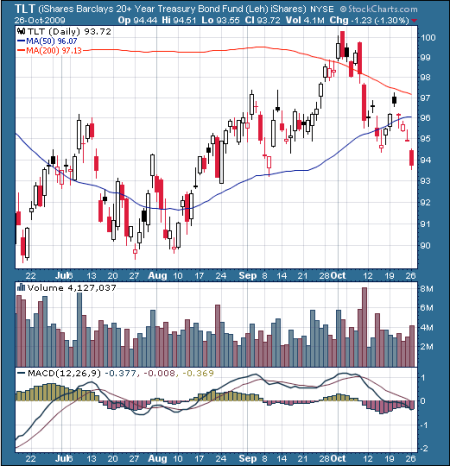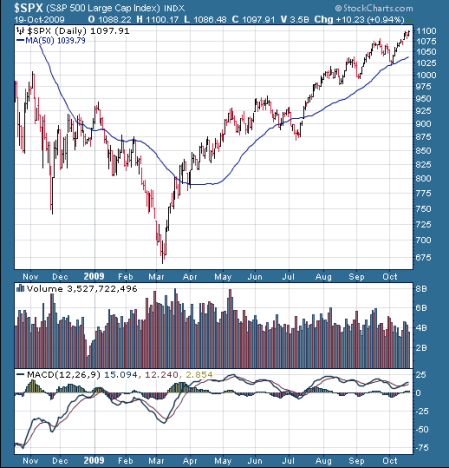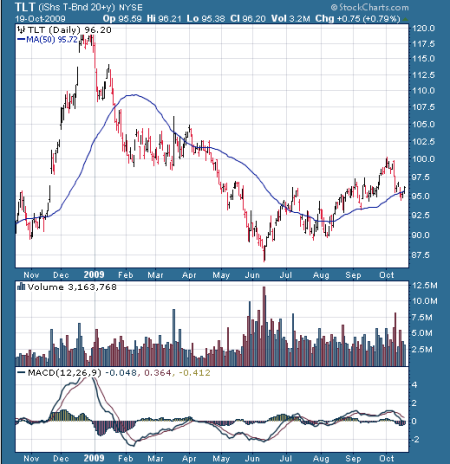SPX – 1066.94
DJIA – 9867
October 27, 2009
“One of the favorite games on Wall Street is the big, dramatic call. Predictions that the trend is about to change garner lots of attention and allow market pundits to pontificate over weighty matters that they have been contemplating. The problem is that getting the timing right is most often a matter of luck. Market players are usually better off just sticking with the trend and using good money-management discipline to move them in and out of the market.”
-James “Rev Shark” DePorre
Markets Will Lead Tomorrow’s Headlines
Major excesses are invariably corrected in three stages according to studies by Robert Farrell who used to be the head technical research at Merrill Lynch. The first stage takes the form of a sharp, extensive decline, sometimes lasting one to two years.
The second stage is a snap back, partial recovery; it could last a year or longer as well. After the recovery, the third stage is drawn out and often the longest until it ends in disinterest, neglect and undervaluation. We had capitulation into the March low but I suspect disinterest lies somewhere ahead.
Following the housing bubble and derivatives excess, the government threw a lot at the wall to avert the second Great Depression and subsequent stock market actions tells us enough stuck. It’s the successful exit that could prove tricky, perhaps setting the stage for what Hyman Minksky would call the next phase of instability.
“We are now at the point where we can begin to wind down the programs that really defined TARP in its initial stages,” said Treasury Secretary Tim Geithner. My mischievous take was to lump the three “cash for trash” programs under the acronym for Bank Asset Relief Funding, BARF.
Financial Times associate editor Wolfgang Munchaup explains, “Successful monetary policy would be like walking along a perilous ridge, on either side of which lies a precipice of instability.” Look to one side as the Fed and other central banks begin to implement exit strategies in 2010 and it seems another price decline for risky assets could lie ahead. On the other side, there’s the risk of currency debasement and a bond market crash if central banks keep cranking out paper money at full speed.
The financial markets will sniff out developments first and months in advance so stay tuned. Today’s technical analysis will lead tomorrow’s headlines. All you can buy in the stock market is an uncertain future. The past is not for sale. It’s this uncertainty that presents the opportunity to capture the swing between perception and reality.
Near-term, the S&P 500 (SPX) rallied to a slight new recovery high last Wednesday (1101.36) and reversed, closing lower on higher volume. A series of daily reversals over the past two weeks calls for caution as does the SPX closing just under its 20-day moving average.

S&P 500 - Daily (Source: StockCharts.com
NYSE net volume has not been in synch with the rally since the September 23 high. After it overbalanced with a (56.8) peak reading, it followed with +47.5. The peak reading on the latest short-term decline is (33.3) as of yesterday, and it wouldn’t take much selling today to reconfirm downtrend or much buying for NYSE net volume to overbalance in favor of uptrend if the market were to rally from this point.
NASDAQ net volume hasn’t overbalanced yet but its +42.5 peak on the last rally didn’t overcome a (43.4) hurdle rate. To overbalance and signal downtrend requires a reading higher than the last peak but it’s only (20.2) so far. There hasn’t been much selling on either NASDAQ or the NYSE but buyers disappeared.
Intermediate-term, the Market Trend Indicator (MTI) remains in an Uptrend because each key index is above its respective 18% weekly exponential average. The SPX’s 18% average is 1045.25 and the DJIA’s is 9972. The New York Advance/Decline line is 3,614 advances above its 18% average.
The MTI reading remains in an uptrend until at least one index closes below its 18% average. The indication shifts to neutral if one or two closes below its 18% average; the MTI changes to downtrend if all three indexes close below their 18% average.
I track two other trend-following indicators to identify and follow swings lasting weeks to months. The 21-day rule and 3-day swing charts are also indicating uptrend. A SPX trade below 1019.75 would signal a change in trend by both.
I prefer to trade intermediate-term trends lasting weeks to months, planning ahead and using exchange traded funds (ETFs) to capture market and sector moves. I believe this sort of planned, deliberate speculation produces the most dependable form of trading. ETFs allow speculators to side step the risk of dramatic plunges suffered by individual stocks if earnings miss or fundamental disappointments unfold.
You can also enter long-term stop orders with ETFs to limit losses and lock in profits, so you’re not necessarily glued to the tape. A speculative strategy doesn’t work without this component.
I realize readers are all over the map, ranging from short-term traders jumping in and out of set ups in individual stocks to long-term investors with a buy-and-hold strategy. Hopefully, you’ll find my insights of value whichever strategy you employ, just make sure you have one so you’ll know how to react when conditions change.
My sense is that despite the pain to date, a lot of short-term traders are picking at the top. Of course, even if they catch it, they’ll pocket little with time horizons that stretch from minutes to days. Longer-term, there’s no shortage of “technical” bears, mostly out of the Elliott Wave camp even though their counts are all over the map.
As for group action, the commodity-based sector and financials have been as good as any. If the dollar manages to mount what I believe is a counter-trend rally, it may be time for a pullback in commodity-oriented stocks. I’m not as constructive for continued leadership by financials as the Fed begins to struggle with an exit strategy.
In general, it’s been a “buy low, sell high” traders market, as opposed to continued momentum by the leaders as typically found in healthy markets. Group leadership continues to shift in a ranking of 100 groups I track.
For example, as late as the week ended October 9, the top ten group list as measured by relative strength included Aluminum (now #24) and Gambling (now #28). Airlines were in the top ten group on the week ended October 16 and now rank #54, leading the Transportation index lower. Home Construction was in the top ten group list September 4 and it’s now in the bottom ten (#97).
Home prices never fell to levels consistent with long-term price-to-income and price-to-rent ratios, helped in part by Treasury purchases of mortgage-backed securities and a tax credit for first-time home buyers. The Treasury Department determined that the government reimbursed about $139 million to more than 19,000 filers for possibly fraudulent first-time home buyer tax credits.
The government’s track record and the big bank bailout may be behind why so many people are worried about government-sponsored healthcare despite recognition the current system doesn’t work very well. Peggy Noonan explained in an editorial in The Wall Street Journal, “People who oppose a health-care overhaul are not in love with insurance companies. They’re not even in love with the status quo. Everyone knows the jerry-built system of the past half-century has weak points. They just don’t think the current plan will shore them up. They think the plan would create new weak points and widen old ones. They think this because they have brains.”
Back to other financial markets, long-term government bond prices fell enough to confirm downtrend when using TLT as a proxy, it traded below its September 9 low of 93.52. The easiest way to be short this market is to be long TBF (ProShares Short Barclay’s 20-year+ Treasury ETF) or for double leverage, TBT (ProShares UltraShort Barclay’s 20-year+ Treasuries). I prefer a relatively tight stop point if wrong, just above the TLT’s October 20 high of 97.25.

TLT - Daily (source: StockCharts.com

TLT (Barclays 20-yr+ Treasury ETF (Source: StockCharts.com)
The dollar popped yesterday after trading on the side for two days. It would take a U.S. Dollar index trade above 77.47 from here to indicate to me that an intermediate-term swing is underway. Perhaps it can return to “best horse in a glue factory” status if stock prices correct.

U.S. Dollar Index - Weekly (Source: StockCharts.com)
With regards to gold, I plan to key in how it reacts if the dollar rallies. It remains in strong positions as long as it holds above the trendline connecting the March 2008 and February 2009 highs. I recommend keeping trailing stops loose for now (just beneath the August 17 low, $932.75 2nd fix) to accommodate any possible correction. The plan would be to tighten up trailing stops if gold fever engulfs the public. “Gold still represents the ultimate form of payment in the world,” said Alan Greenspan in May 1999. “Fiat money in extremis is accepted by nobody. Gold is always accepted.”

GLD (Gold ETF) - Weekly (Source: StockCharts.com)
The lead front page article in last Sunday’s San Francisco Chronicle told of more people panning for gold in the Sierra’s to take advantage of higher gold prices. It doesn’t quite qualify, in my mind, as evidence of a top in the making given the human interest angle, and the Sierra’s are a nice place to hang out. If and when gold makes the front page of daily newspapers in large headlines tied to easy money, it will be time to look for the exit.
Hopefully, newspapers last that long. I’ll miss them when they’re gone. The Audit Bureau of Circulations reported that the decline in average daily circulation is accelerating. It dropped 10.6% in the six month period between April and September, following 7.1% decline in the preceding period between October 2008 and March 2009, and a 4.6% shrinkage in the year-earlier April through September 2008 period.
I’ll close with a fascinating statistic from Stephanie Pomboy at MacroMavens via Alan Abelson’s column in this week’s Barron’s. She figured public companies cut labor costs $327 billion over the past year while corporate earnings declined $177 million over the same period. According to her calculations, consumer spending would have to climb over 3% for revenue to match the cost savings.
Conclusion:
My recommend stop sell level under the SPX’s 3-day swing low of 1019.75 on October 2 remains unchanged. The equivalent figure for the Nasdaq 100 (NDX) is just below 1656.57, up from 1585.56 previously. I plan to initiate short positions when the MTI signals downtrend and add to those positions (if it follows in this order) when the 21-day rule and 3-day swing charts confirm. For weakness, I prefer ETFs tied to small cap indices cyclical issues in weak stock groups
For investors, internal technical dynamics such as the A/D line and new highs point to higher prices following any correction, but it’s time to plan ahead as to what percentage of assets to hold in stocks once longer-term technical tools indicate that the cyclical bull market has run its course. If you’re strictly bottoms up, Warren Buffett advises, “The stock market is there only as a reference point to see if anybody is offering to do anything foolish. When we invest in stocks, we invest in businesses. You simply have to behave according to what is rational rather than according to what is fashionable.”
The information contained herein is based on sources that William Gibson deems to be reliable but is neither all-inclusive nor guaranteed for accuracy by Mr. Gibson and may be incomplete or condensed. The information and its opinions are subject to change without notice and are for general information only. Past performance is not a guide or guarantee of future performance. The information contained in this report may not be published, broadcast, rewritten or otherwise distributed without consent from William Gibson.

 Uncategorized |
Uncategorized | 
 Posted by mrmkt
Posted by mrmkt 




